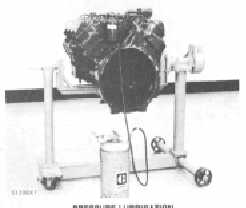TM 5-3805-260-24
ENGINE TEST PROCEDURE
LUBRICATION FOR A REBUILT ENGINE
It is very important for a rebuilt engine to have
"adequate" (needed) lubrication during the first seconds
of operation. A "dry start" (without needed lubrication) on
a rebuilt engine can cause bearing damage.
When an engine is rebuilt with new parts, oil is put
on each part as it is installed This is generally enough
lubrication for engine start-up. However, this lubrication
may not be enough or may be lost if the rebuilt engine is
place in storage for any length of time.
When a factory assembled short block assembly is
installed, the oil used at the factory has, to give this
needed lubrication. However, the factory oil application
can flow off the parts in a short block during storage or
shipment. As a result the parts in a rebuilt engine will not
have "adequate" lubrication start-up.
To prevent the possibility of a "dry start" and bearing
damage during the first seconds of running, use the
1P540, Flow Checking Tool Group, and Shop air
pressure to pressure lubricate (fill the main oil passage
with oil under pressure) all rebuilt engines.
Procedure for Pressure Lubrication
1. Clean the tank of the IP540 Flow Checking Tool
Group thoroughly, and set the pressure regulator to
35 5 psi (240 + 35 kPa).
WARNING
Air pressure should not be more than 50 psi (345
kPa) at any time.
2. Put approximately one gallon of engine oil In the tank.
PRESSURE LUBRICATION
(Using the 1 P540 Flow Checking Tool Group)
3. Connect the tools to the engine as shown. The
tap shown is connected to the main oil passage.
4. Add air pressure to the tank, with the regulator set at
35 + 5 psi (240 + 35 kPa). Although the tank does
haxve a hand pump, it is difficult to get enough air
pressure to do the job with the hand pump.
Therefore, use of shop air is recommended.
5. Let the one gallon of engine oil flow into the oil
passage under pressure.
When filling the crankcase, put in one gallon of oil
less than the recommendation in the Lubrication and
Maintenance Guides, if engine has received this
pressure lubrication application. Also if the engine is not
going to be used for a long time, do the above
procedure again before the first starting.
If shop air is not available for charging the tank, the
hand pump may be used to get the minimum required
pressure.
CAUTION
Do not use the same 1 P540 Flow Checking
Tool
Group
for
both
"pressure
lubrication
application" and for checking fuel flow. Incorrect
cleaning is probable if the tool is used for both
fuel and lube oil. Even a minute amount of dirt in
the fuel system can cause fuel nozzle failure.
DYNAMOMETER TEST PRECAUTION
To avoid possible engine damage while testing on a
dynamometer, the thermostats must be installed and the
shunt line connected as shown.
SHUNT LINE CONNECTED TO ENGINE
3-393



